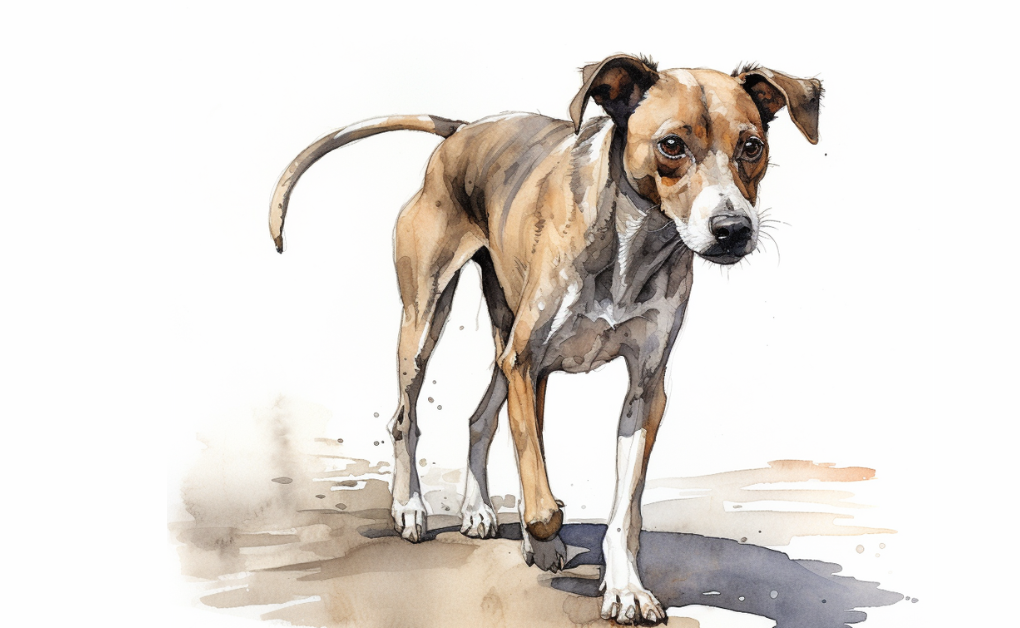What is Chronic Kidney Disease in Dogs?
What is it?
How is it Treated?
Breed Predispositions
Bull Terriers Doberman Pinschers German Shepherds Golden Retrievers Labrador Retrievers Boxers Cocker Spaniels Rottweilers Shar Peis Bernese Mountain Dogs
Introduction
Over the past few weeks, Helen had become increasingly concerned about her beloved senior Labrador Retriever, Daisy, who seemed to be losing her appetite and becoming increasingly lethargic. Daisy was also drinking water excessively and urinating more frequently than usual. Worried about her furry companion’s health, Helen scheduled an appointment with their trusted veterinarian. After a comprehensive examination and several diagnostic tests, the vet revealed that Daisy was suffering from chronic kidney disease, a condition that Helen had never encountered before.
Chronic Kidney Disease in dogs (CKD), also known as chronic renal disease, is a slowly progressing condition in dogs that causes a gradual loss of kidney function over an extended period. These vital organs serve several essential roles, such as purifying blood by filtering out waste materials, maintaining electrolyte balance, and generating urine. As CKD progresses through its chronic degradation stages, these functions gradually decline, leading to a harmful accumulation of toxins in the dog’s body.
CKD’s development starkly contrasts with acute renal failure, which manifests suddenly and rapidly. Polycystic kidney disease, characterized by the growth of numerous cysts in the kidneys, can also lead to CKD. While CKD can afflict dogs at any age, it is typically observed in middle-aged and older dogs. This severe, potentially fatal condition demands diligent management to decelerate its progression and uphold the dog’s quality of life.
Types of Kidney Disease in Dogs
Kidney disease in dogs is typically categorized into two types: Acute Kidney Injury (AKI) and Chronic Kidney Disease (CKD).
- Acute Kidney Injury (AKI): AKI, also known as Acute Renal Failure, is a sudden and severe decrease in kidney function over days or weeks. A direct injury or toxin ingestion, such as antifreeze, certain medications, or specific foods like grapes and raisins, often causes it. AKI can lead to a rapid buildup of waste products in the bloodstream, causing severe symptoms that require immediate veterinary attention. However, AKI can be reversed if caught early and treated aggressively.
- Chronic Kidney Disease (CKD): CKD, also known as Chronic Renal Failure, is a long-standing disease of the kidneys that occurs over months or years. Age-related wear and tear, congenital abnormalities, or long-term damage from kidney infections or high blood pressure often cause CKD. With CKD, the kidneys slowly lose their ability to filter waste products from the bloodstream adequately. While CKD is not reversible, it can often be managed with dietary modifications, medications, and other supportive care to slow disease progression and maintain quality of life.
The stages of kidney disease in dogs are generally divided based on the level of kidney function as determined by blood and urine tests. The International Renal Interest Society (IRIS) has established a set of stages:
- Stage 1: Kidney disease is evident, but the dog’s blood work remains normal. This stage is typically identified through urinalysis or imaging studies.
- Stage 2: Kidney disease with mild azotemia, characterized by increased levels of waste products like creatinine and urea in the blood. At this stage, the dog may or may not show clinical signs of disease.
- Stage 3: Kidney disease with moderate azotemia. Clinical signs like increased thirst and urination, loss of appetite, and weight loss are more likely present at this stage.
- Stage 4: Kidney disease with severe azotemia. This stage indicates advanced kidney disease, and dogs may exhibit more severe clinical signs, including nausea, vomiting, weight loss, dehydration, and weakness.
Each stage has sub-stages based on the dog’s blood pressure and the amount of protein in its urine, which are indicators of the disease’s severity. Therefore, regular monitoring and follow-up with a veterinarian are crucial to managing kidney disease in dogs and maintaining their quality of life.
Dog’s Kidney – What Do They Do?
Dog’s kidneys have multiple vital functions in the body. Here are a few of the key roles they play:
- Eliminating Waste and Toxins: The kidneys’ primary function is to filter out waste and toxins from the bloodstream. These waste products are byproducts of metabolism that the body needs to eliminate. Therefore, the kidneys filter the blood and produce urine, which carries these waste products out of the body.

- Regulating Fluid and Electrolyte Balance: Kidneys also play a crucial role in maintaining the body’s water balance and various electrolytes, including sodium, potassium, and calcium. They do this by adjusting the amount of water and electrolytes that are reabsorbed back into the body and the amount that is excreted in the urine.
- Regulating Blood Pressure: The kidneys contribute to the regulation of blood pressure. They do this by adjusting the blood volume (by controlling the amount of water excreted or retained) and by releasing an enzyme called renin, which helps control the constriction or dilation of blood vessels.
- Producing Erythropoietin: The kidneys produce a hormone called erythropoietin, which stimulates the bone marrow to produce red blood cells. This is particularly important when the body is responding to low oxygen levels.
- Metabolizing Vitamin D: The kidneys play a role in metabolizing vitamin D, a nutrient essential for bone health.
Causes of Chronic Kidney Disease in Dogs
Chronic Kidney Disease (CKD) in dogs, also referred to as “chronic kidney disease is kidney disease,” is a condition where the kidneys gradually lose their ability to function properly over time. Unlike acute kidney disease, which develops suddenly, CKD is a disease that has been present for a long time and typically affects older dogs. Several potential factors can contribute to this condition:
- Age – Aging is a primary risk factor for CKD. Kidney function naturally declines as dog’s age, which can eventually escalate to chronic kidney disease and even severe kidney failure.
- Breed Disposition – Certain breeds, such as Cocker Spaniels, Bull Terriers, German Shepherds, and Dalmatians, are genetically predisposed to developing kidney disease.
- Underlying Health Conditions – Diseases such as diabetes, heart disease, high blood pressure, or autoimmune diseases can contribute to the development of CKD. These conditions can trigger metabolic acidosis, which often accompanies kidney disease, further exacerbating the severity of the disease.
- Infections and Diseases – Certain bacterial infections or diseases can cause chronic kidney damage if not treated promptly. Lyme disease, leptospirosis, and pyelonephritis are examples of such conditions.
- Toxins and Medications – Chronic exposure to certain toxins, including specific medications or substances like antifreeze, can damage the kidneys over time. In addition, long-term use of certain medications, such as nonsteroidal anti-inflammatory drugs (NSAIDs) or some antibiotics, can also potentially impact kidney function, leading to chronic kidney failure.
- Kidney Stones – Chronic kidney stones can cause damage over time, leading to CKD, and in severe cases, they may precipitate acute on chronic kidney disease.
- Cancer – In some cases, cancers like lymphoma or carcinomas can affect the kidneys, leading to CKD.
CKD affects up to 10% of dogs and 35% of cats, which is lower for the general population. Remember that early detection and management of CKD can significantly improve a dog’s quality of life and slow the progression of the disease. Therefore, if you notice any changes in your dog’s behavior, appetite, or water consumption, you must consult a veterinarian promptly.
Symptoms of Chronic Renal Failure in Dogs
As chronic kidney disease takes hold in a dog’s kidneys, various clinical signs manifest, indicating kidney disease progression. These symptoms, commonly observed in dogs with naturally occurring chronic renal conditions, can include:
- Excessive thirst and increased urination
- Unexplained weight loss
- Loss of appetite or total anorexia
- Vomiting episodes
- Episodes of diarrhea or constipation
- Signs of lethargy or depression
- Distinctly bad breath with a chemical-like odor
- Presence of ulcers in the mouth
- Pale appearance of the gums
- Detection of blood in the urine
- Perceptible abdominal discomfort
- Pain in bones or joints
- Increased blood pressure levels
These symptoms can also be associated with kidney disease in small animals. However, it’s vital to remember that these signs might differ based on the severity and stage of the disease; thus, consulting a veterinarian is crucial for correct diagnosis and treatment.
Diagnosis of Chronic Kidney Disease in Dogs
Identifying chronic kidney disease (CKD) in dogs requires an intricate process involving various tests and examinations to confirm the kidney problem.

Blood Tests
Blood tests are one of the initial diagnostic methods in dogs suspected of CKD. Vets check for elevated blood urea nitrogen (BUN) levels and creatinine – waste substances effectively filtered out by healthy kidneys. High levels of these substances suggest impaired kidney function.
Veterinarians also examine electrolyte levels, protein content, and red and white blood cell counts for additional insights into the dog’s overall health and the extent of kidney dysfunction.
Urinalysis
A urinalysis proves critical for the diagnosis of CKD in dogs. This test provides essential information about the kidneys’ capacity to concentrate urine – a function often affected by kidney disease. Furthermore, urinalysis can detect protein or blood in the urine, indicating kidney damage.
Urinary tract infections, which could exacerbate kidney issues or surface as a secondary complication of kidney disease, can also be identified through urinalysis. This examination, therefore, is instrumental in evaluating kidney function and detecting concurrent complications.
Ultrasound
Employing ultrasound, a non-invasive imaging technique, vets can observe the kidneys in real-time in dogs suspected of having CKD. Any size, shape, and internal structure change could indicate kidney disease. For instance, kidneys may appear smaller and irregular in chronic cases. Moreover, ultrasound can spot abnormalities like kidney stones or tumors, enabling a distinction between chronic kidney disease and other kidney-related conditions. Hence, it yields invaluable information assisting diagnosis and informing treatment strategies.
X-rays
X-rays or radiography offers another diagnostic tool for vets to assess dogs suspected of CKD. Though it doesn’t offer as detailed an image as ultrasound, it provides a useful overview of the kidney’s size and position. Abnormalities such as stones, tumors, or changes in kidney size associated with chronic disease can be highlighted through X-rays. Radiographs also uncover abnormalities in other organs that could influence kidney function. While not kidney-specific, X-rays help sketch a comprehensive diagnostic picture and rule out other potential conditions.
Biopsy
A kidney biopsy, though less common due to its invasive nature, can still be useful in diagnosing CKD. A small tissue sample from the kidney is extracted and analyzed under a microscope, revealing the presence and extent of damage, inflammation, scarring, or other pathological changes. However, due to potential complications, including bleeding, this test is typically reserved for cases where the diagnosis remains unclear after other non-invasive tests.
Blood Pressure Monitoring
Blood pressure monitoring is critical to CKD diagnosis, as hypertension (high blood pressure) is often a secondary complication of kidney disease. With kidneys playing a key role in blood pressure regulation, high blood pressure can indicate malfunctioning kidneys. Uncontrolled, persistent high blood pressure can further damage the kidneys, perpetuating a harmful cycle. Therefore, blood pressure monitoring is integral to diagnosing and managing CKD. An early diagnosis can significantly influence the treatment approach and the dog’s long-term health outlook.
Treatment for Canine Kidney Failure
The variety of treatment options for chronic kidney disease (CKD) in dogs largely depends on the root cause. For instance, if diabetes mellitus is the primary issue, dietary management may suffice. However, additional treatment will be necessary when conditions such as proteinuria, azotemia, or hypertension are present.
Dietary Modification
Dietary modification for treatment is one of the most efficient methods for managing CKD in dogs. This often includes minimizing protein, phosphorus, and sodium intake while boosting omega-3 fatty acids. This dietary shift can assist in decreasing inflammation and slowing the progression of the disease.
Fluid Therapy
Dehydration is a frequent consequence of chronic kidney disease in dogs. As such, fluid therapy, including administering IV fluids, becomes an integral part of the treatment regimen. Depending on the disease’s severity, this can be done intravenously or subcutaneously to maintain hydration and eliminate toxins.
Medications
Various medications can be prescribed to manage CKD in dogs based on the severity of the disease, the stage as per the International Renal Interest Society’s guidelines for chronic kidney disease, and any other health issues. These pharmaceutical aids help manage symptoms and tackle complications such as high blood pressure, protein loss in urine, and anemia. Dogs with acute renal failure may not respond to treatment as effectively as those with chronic conditions. Some types of medications that may be used include:
- Phosphate Binders: In CKD dogs, high phosphorus levels in the blood are typical. Phosphate binders such as aluminum hydroxide can help reduce these levels.
- ACE Inhibitors: Medications like enalapril or benazepril are frequently administered to decrease proteinuria in dogs and cats and aid in controlling high blood pressure, a prevalent complication in CKD dogs.
- Antihypertensives: Medications like amlodipine may be needed to manage further high blood pressure, which can exacerbate kidney damage.
- Diuretics: In certain instances, diuretics like furosemide may assist in the body’s expulsion of excess fluid, thereby reducing the kidneys’ workload.
- Erythropoiesis-Stimulating Agents: These medications, including darbepoetin, can trigger the production of red blood cells, which is beneficial since anemia often accompanies CKD.
- Appetite Stimulants: Since CKD often results in reduced appetite in dogs, these may be employed to encourage food intake.
- Antiemetics: Medications such as maropitant may be used to manage common symptoms like vomiting in CKD.
- Gastroprotectants: Drugs like famotidine or omeprazole may be administered to shield the stomach lining and mitigate the risk of ulcers.
It’s important to remember that every dog with CKD is distinct and will need a treatment strategy tailored to their needs and circumstances. Consequently, consistent collaboration with your veterinary internal medicine specialist is crucial in devising the best plan for your dog.
Dialysis
Dialysis is used when medical treatment has failed, but the chances of dying without dialysis are almost 100%. This happens when the kidneys can no longer filter toxins from the blood. Dialysis is a procedure that artificially removes waste products and excess fluids from the dog’s blood.
Two main types of dialysis are used in treating chronic kidney disease in dogs: hemodialysis and peritoneal dialysis.
- Hemodialysis: This is the most commonly used form of dialysis in veterinary medicine. It involves using a machine to filter waste and excess fluid from the dog’s blood. The blood is circulated through a dialyzer or artificial kidney, where toxins and wastes are removed, and then the cleaned blood is returned to the dog’s body. Hemodialysis is usually performed in a hospital setting and may be required several times weekly. It is most often used in acute cases of kidney failure where immediate intervention is necessary.
- Peritoneal Dialysis: This method uses the dog’s peritoneum (the abdominal cavity lining) as a natural filter. A special solution is infused into the abdominal cavity through a catheter. The peritoneal membrane allows waste products and excess fluid to pass into the solution. After a set amount of time, the solution is drained from the abdomen, carrying the waste and toxins. This method can be performed at home but requires careful monitoring and training.
Both types of dialysis can be effective in managing kidney disease, but their use depends on the specific situation and resources available. In general, dialysis is reserved for severe or acute cases of kidney failure, where the benefits outweigh the significant costs and potential complications associated with these procedures.
Kidney Transplant
While kidney transplants are not common in dogs, they can be an option for some. This involves replacing the diseased kidneys with a healthy one from a donor.
The exact treatment plan will depend on the severity and cause of the kidney disease and your dog’s overall health. Regular check-ups are essential to monitor the progression of the disease and adjust the treatment plan accordingly. The main goal is to slow down the progression of the disease, manage symptoms, and improve the quality of life for your dog.
How to Prevent Chronic Kidney Disease in Dogs
In dogs, thwarting the onset of chronic kidney disease (CKD) necessitates adhering to a wholesome lifestyle and routine veterinary examinations. Below are some prevention strategies –
- Nutrition – Administering a high-grade, balanced diet can uphold overall health and decelerate the advancement of kidney disease during its nascent stages. Ensure you comply with your vet’s nutritional advice to maintain functional kidney health.
- Periodic Veterinary Examinations – Frequent veterinary check-ups can aid in the early detection of potential health anomalies. Routine blood and urine analysis can be instrumental in identifying the preliminary stages of decreased kidney function.
- Hydration – Sufficient water consumption is pivotal for healthy kidneys. Ascertain that your dog continually has access to clean, fresh water. Sometimes, your vet might advocate for wet food to augment fluid intake.
- Weight Management – Obesity can catalyze the onset of various ailments, including CKD. You can ensure optimal health by managing your dog’s weight with a nutritious diet and regular exercise.
- Toxin Avoidance – Certain substances can harm the kidneys, including antifreeze, specific medications, and some plant species. Ensure these substances are beyond your dog’s access.
- Oral Health – Dental conditions can contribute to kidney complications. Periodic dental cleanings and at-home oral care can serve as preventive measures.
- Pharmaceutical and Supplemental Interventions – When recommended by a vet, specific medications and supplements may aid in preserving kidney health, particularly in dogs genetically predisposed to developing kidney disease.
Remember that while these strategies can curtail the risk, they cannot completely preclude the development of CKD, which can sometimes manifest due to factors beyond a pet owner’s control, such as aging or genetic predisposition. The management of chronic kidney disease then becomes crucial.
Frequently Asked Questions
Disclaimer: The information provided on this veterinary website is intended for general educational purposes only and should not be considered as a substitute for professional veterinary advice, diagnosis, or treatment. Always consult a licensed veterinarian for any concerns or questions regarding the health and well-being of your pet. This website does not claim to cover every possible situation or provide exhaustive knowledge on the subjects presented. The owners and contributors of this website are not responsible for any harm or loss that may result from the use or misuse of the information provided herein.







